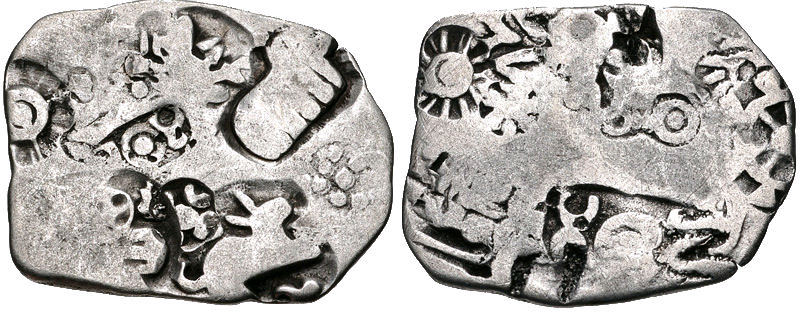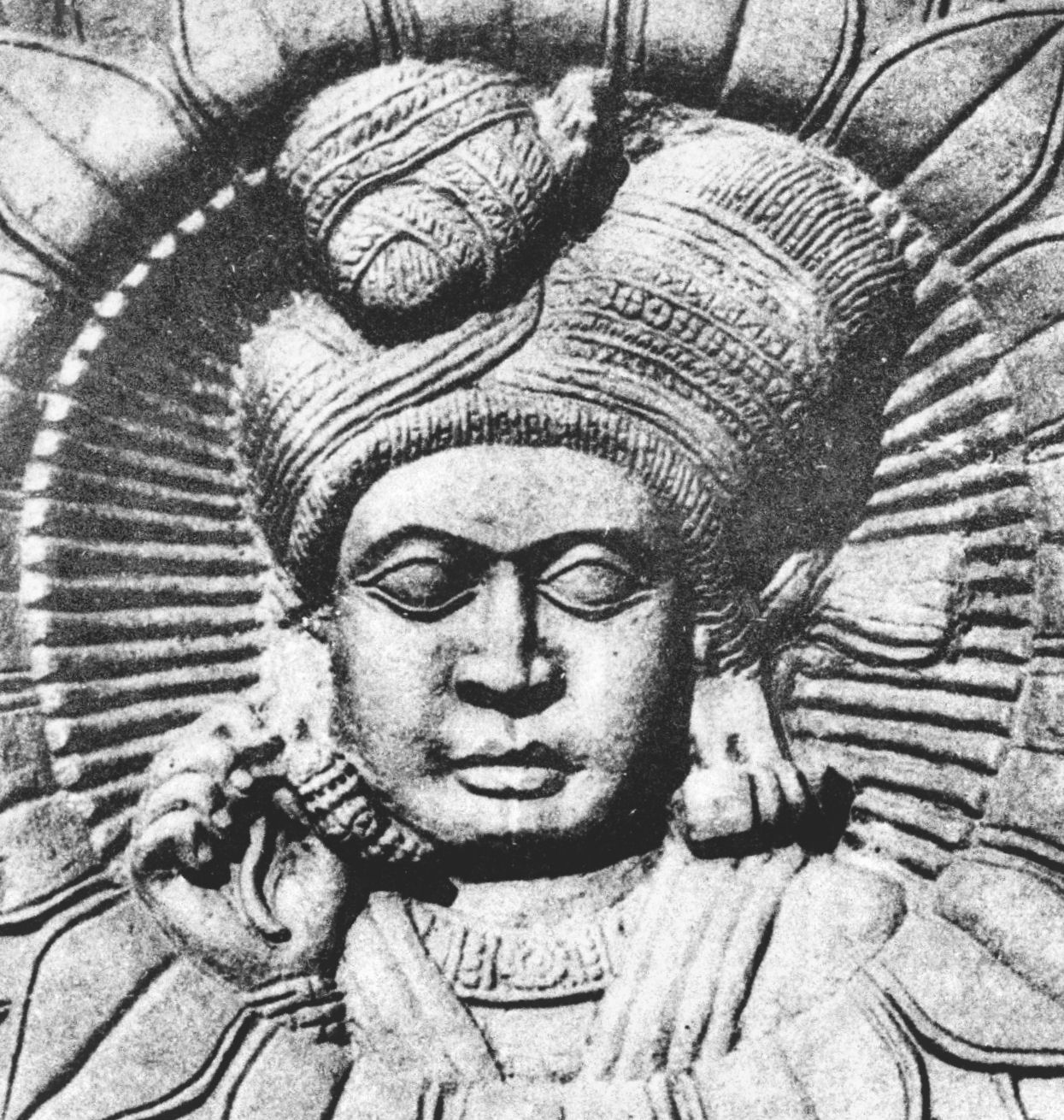|
Magadha
Magadha was a region and kingdom in ancient India, based in the eastern Ganges Plain. It was one of the sixteen Mahajanapadas during the Second Urbanization period. The region was ruled by several dynasties, which overshadowed, conquered, and incorporated the other Mahajanapadas. Magadha played an important role in the development of Jainism and Buddhism and formed the core of the Maurya Empire (ca. 320–185 BCE). Geography The territory of the Magadha kingdom proper before its expansion was bounded to the north, west, and east respectively by the Gaṅgā, Son, and Campā rivers, and the eastern spurs of the Vindhya mountains formed its southern border. The territory of the initial Magadha kingdom thus corresponded to the modern-day Patna and Gaya districts of the Indian state of Bihar. The region of Greater Magadha also included neighbouring regions in the eastern Gangetic plains and had a distinct culture and belief. History Vedic period (semi-legendary) (ca. 170 ... [...More Info...] [...Related Items...] OR: [Wikipedia] [Google] [Baidu] |
Nanda Dynasty
The Nanda Empire was a vast empire that governed in Magadha and Gangetic plains with an enormous geographical reach in 4th-century BCE northeastern India, with some accounts suggesting existence as far back as the 5th century BCE. The Nandas built on the successes of their Haryanka and Shaishunaga predecessors and instituted a more centralised administration. Ancient sources credit them with amassing great wealth, which was probably a result of the introduction of a new currency and taxation system. Ancient texts also suggest that the Nandas were unpopular among their subjects because of their low-status birth, excessive taxation, and general misconduct. The last Nanda king Dhana Nanda was overthrown by Chandragupta Maurya, founder of the Maurya Empire. Modern historians generally identify the ruler of the Gangaridai and the Prasii mentioned in ancient Greco-Roman accounts as a Nanda king. While describing Alexander the Great's invasion of Punjab (327–325 BCE), Greco-Ro ... [...More Info...] [...Related Items...] OR: [Wikipedia] [Google] [Baidu] |
Maurya Empire
The Maurya Empire was a geographically extensive Iron Age historical power in South Asia with its power base in Magadha. Founded by Chandragupta Maurya around c. 320 BCE, it existed in loose-knit fashion until 185 BCE. The primary sources for the written records of the Mauryan times are partial records of the lost history of Megasthenes in Roman texts of several centuries later; the Edicts of Ashoka, which were first read in the modern era by James Prinsep after he had deciphered the Brahmi script, Brahmi and Kharoshthi script, Kharoshthi scripts in 1838; and the ''Arthashastra'', a work first discovered in the early 20th century,: "... another source that enjoyed high standing as a description of the early Mauryan state was the Arthashastra, a treatise on power discovered in the early twentieth century." and previously attributed to Chanakya, but now thought to be composed by multiple authors in the first centuries of the common era. Archaeologically, the period of Maury ... [...More Info...] [...Related Items...] OR: [Wikipedia] [Google] [Baidu] |
Maurya Empire, C
The Maurya Empire was a geographically extensive Iron Age historical power in South Asia with its power base in Magadha. Founded by Chandragupta Maurya around c. 320 BCE, it existed in loose-knit fashion until 185 BCE. The primary sources for the written records of the Mauryan times are partial records of the lost history of Megasthenes in Roman texts of several centuries later; the Edicts of Ashoka, which were first read in the modern era by James Prinsep after he had deciphered the Brahmi and Kharoshthi scripts in 1838; and the ''Arthashastra'', a work first discovered in the early 20th century,: "... another source that enjoyed high standing as a description of the early Mauryan state was the Arthashastra, a treatise on power discovered in the early twentieth century." and previously attributed to Chanakya, but now thought to be composed by multiple authors in the first centuries of the common era. Archaeologically, the period of Mauryan rule in South Asia falls in ... [...More Info...] [...Related Items...] OR: [Wikipedia] [Google] [Baidu] |
Rajgir
Rajgir, old name Rajagriha, meaning "The City of Kings," is an ancient city and university town in the Nalanda district of Bihar, India. It was the capital of the Haryanka dynasty, the Pradyota dynasty, the Brihadratha dynasty, the Mauryan Empire, and it was the retreat center for the Buddha and his sangha. Other historical figures such as Mahavira and king Bimbisara lived there, and due to its religious significance, the city holds a place of prominence in Hindu, Buddhist and Jain scriptures. Rajgir was the first capital of the ancient kingdom of Magadha, a state that would eventually evolve into the Mauryan Empire. It finds mention in India's renowned literary epic, the Mahabharata, through its king Jarasandha. The town's date of origin is unknown, although ceramics dating to about 1000 BC have been found in the city. The 2,500-year-old cyclopean wall is also located in the region. The ancient Nalanda university was located in the vicinity of Rajgir, and the c ... [...More Info...] [...Related Items...] OR: [Wikipedia] [Google] [Baidu] |
Later Guptas
The Later Gupta dynasty, also known as the Later Guptas of Magadha, were the rulers of Magadha and Malwa from the 6th to 8th centuries CE. The Later Guptas emerged after the disintegration of the Imperial Guptas. However, there is no evidence to connect the two dynasties and the Later Guptas may have adopted the -gupta suffix to link themselves with the Imperial Guptas. There are several important sources of information regarding the Later Guptas including two epigraphs, the Aphsad inscription of Ādityasena, which sets out the genealogy of the ruling family from Kṛṣṇagupta to Ādityasena, and the Deo Baranark inscription of Jīvitagupta II. The Harshacharita of Bāṇabhaṭṭa is also an important source of information as are the records of the Chinese pilgrims Xuanzang and Yijing which also mentions them. The Gaudavaho of Vākpatirāja refers to the victory of King Yashovarman of the Varman dynasty against the king of Magadha, with the scholarly consensus being tha ... [...More Info...] [...Related Items...] OR: [Wikipedia] [Google] [Baidu] |
Mitra Dynasty (Kosambi)
Mitra dynasty of Kosambi was centered on the city of Kosambi at the Vatsa region. Its capital Kosambi was among the most important trade centers in the ancient India. The dynasty also likely controlled territory in nearby regions such as Magadha (Mahajanapada), Magadha. Many of its rulers bear the suffix "-''mitra''" in their names. However, it is disputed how many kings the dynasty was composed of. Dhanabhuti, who is known for Bharhut inscriptions, may have been related to the Mitra dynasty. A number of different, and possibly, related Mitra dynasty (other), Mitra dynasties existed in the northern India, and it is possible that they all can trace their lineage back into the royal house of the Shunga Empire. Common symbols in the coinage of the Mitra dynasty include the tree-in-railing and the Ujjain symbol. Bull is a common animal to appear on the coinage. The Mitra dynasty was ended when Samudragupta of the Gupta Empire annexed Kosambi in the middle of the 4th centur ... [...More Info...] [...Related Items...] OR: [Wikipedia] [Google] [Baidu] |
Shaishunaga Dynasty
The Shaishunaga dynasty (IAST: Śaiśunāga, literally "of Shishunaga") was possibly the second ruling dynasty of Magadha. According to the Buddhist text Mahavamsa, this dynasty was the second ruling dynasty of Magadha, succeeding Nagadashaka of the Haryanka dynasty. The Hindu ''Puranas'' have given a different list with different chronology of the Shaishunaga dynasty kings, whereas Jain texts do not mention this dynasty. History Shishunaga was the founder of the dynasty. He was initially an ''amatya'' or "minister" of the last Haryanka dynasty ruler Nāgadāsaka and ascended to the throne after a popular rebellion in . The capital of this dynasty initially was Vaishali; but later shifted to Pataliputra, near the present day Patna, during the reign of Kalashoka. According to tradition, Kalashoka was succeeded by his ten sons. This dynasty was succeeded by the Nanda dynasty in . Historicity Jain texts have skipped over the Shaishunaga dynasty. They mention instead that ... [...More Info...] [...Related Items...] OR: [Wikipedia] [Google] [Baidu] |
Shunga Empire
The Shunga Empire (IAST: ') was a ruling entity centred around Magadha and controlled most of the northern Indian subcontinent from around 187 to 75 BCE. The dynasty was established by Pushyamitra, after taking the throne of Magadha from the Mauryas. The Shunga empire's capital was Pataliputra, but later emperors such as Bhagabhadra also held court at Besnagar (modern Vidisha) in eastern Malwa. This dynasty is also responsible for successfully fighting and resisting the Greeks in Shunga–Greek War. Pushyamitra ruled for 36 years and was succeeded by his son Agnimitra. There were ten Shunga rulers. However, after the death of Agnimitra, the second king of the dynasty, the empire rapidly disintegrated:K.A. Nilkantha Shastri (1970)''A Comprehensive History of India: Volume 2'' p.108: "Soon after Agnimitra there was no 'Sunga empire'." inscriptions and coins indicate that much of northern and central India consisted of small kingdoms and city-states that were independent ... [...More Info...] [...Related Items...] OR: [Wikipedia] [Google] [Baidu] |
Patna
Patna (; , ISO 15919, ISO: ''Paṭanā''), historically known as Pataliputra, Pāṭaliputra, is the List of state and union territory capitals in India, capital and largest city of the state of Bihar in India. According to the United Nations, as of 2018, Patna had a population of 2.35 million, making it the List of cities in India by population, 19th largest city in India. Covering and over 2.5 million people, its urban agglomeration is the List of million-plus urban agglomerations in India, 18th largest in India. Patna also serves as the seat of Patna High Court. The Buddhist, Hindu and Jain pilgrimage centres of Vaishali district, Vaishali, Rajgir, Nalanda, Bodh Gaya and Pawapuri are nearby and Patna City is a sacred city for Sikhs as the tenth 10th Sikh Guru, Sikh Guru, Guru Gobind Singh was born here. The modern city of Patna is mainly on the southern bank of the river Ganges. The city also straddles the rivers Son River, Son, Gandak and Punpun River, Punpun. The city ... [...More Info...] [...Related Items...] OR: [Wikipedia] [Google] [Baidu] |
Haryanka Dynasty
The Haryanka dynasty was the ruling dynasty of Magadha, according to the Buddhist text Mahavamsa between 544 BC and 413 BC though some scholars favour a later chronology (5th century BCE to first half of 4th century BCE). Initially, the capital was Rajagriha. Later, it was shifted to Pataliputra, near present-day Patna in India during the reign of Udayin. Bimbisara is considered to be the founder of the dynasty. According to the Mahavamsa, Bimbisara was appointed king by his father, Bhattiya, at the age of fifteen. This dynasty was succeeded by the Shaishunaga dynasty. Governance The governance structure of Haryanka dynasty is mentioned in ancient texts. They mention ''gramakas'' (village headmen) who headed village assemblies and ''mahamatras'' (high-ranking officials) who had executive, judicial and military functions. Historically, this period coincided with the Achaemenid conquest of the Indus Valley during the rule of Darius I from about 517/516 BCE. Rulers Bimb ... [...More Info...] [...Related Items...] OR: [Wikipedia] [Google] [Baidu] |








